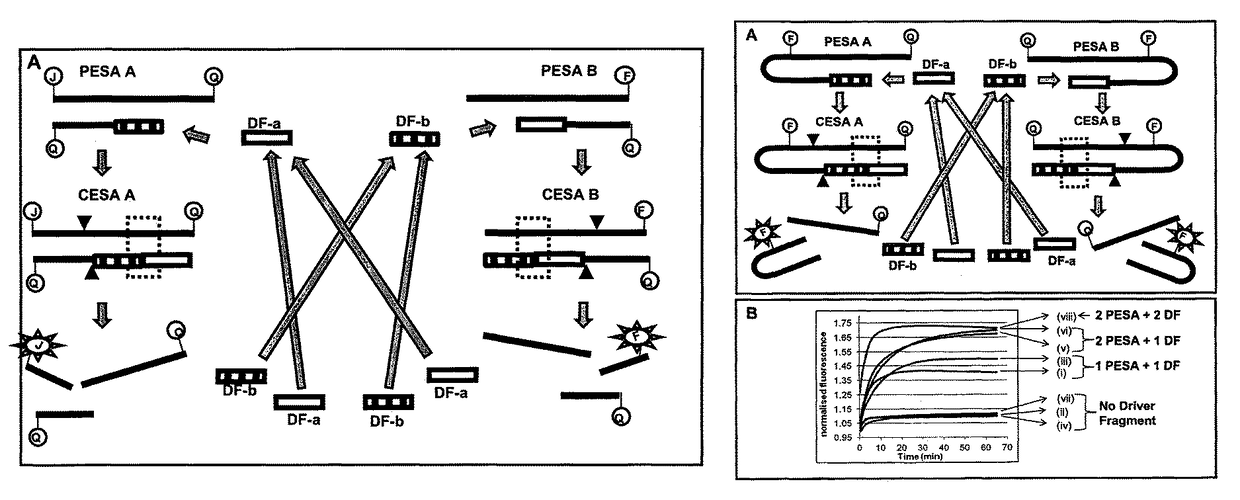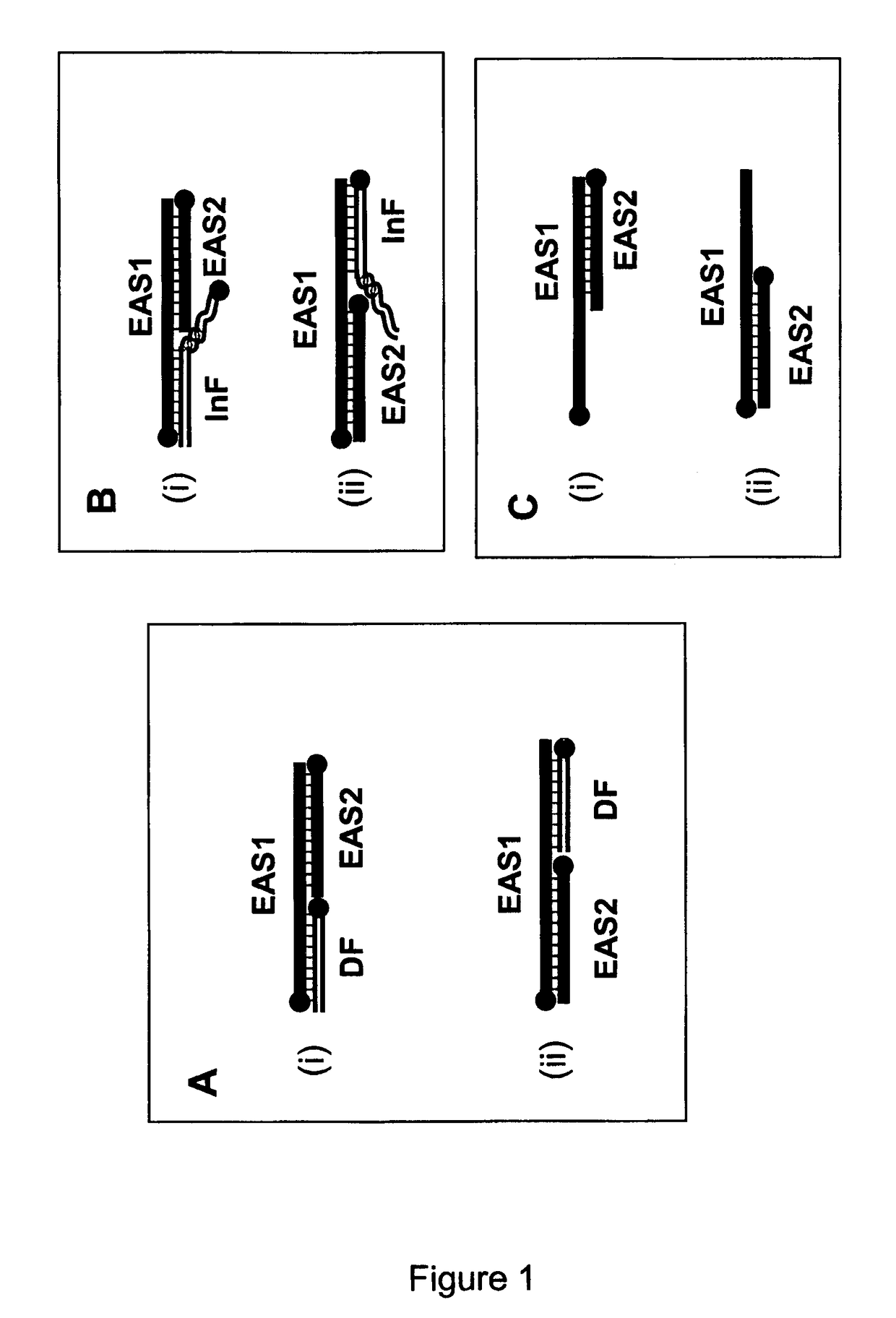Signal amplification
a signal amplitude and signal technology, applied in the field of signal amplitude, can solve the problems of limited sensitivity, affecting the signal strength and the running time required to achieve satisfactory signal strength, and limiting the flexibility of this assay
- Summary
- Abstract
- Description
- Claims
- Application Information
AI Technical Summary
Benefits of technology
Problems solved by technology
Method used
Image
Examples
example 1
[0844]The following example demonstrates the capacity for oligonucleotides to form various duplex structures which are either cleavable or uncleavable by nucleases. Structures which are cleavable by a nuclease are duplex substrates such as CESA complexes and the nuclease in this example is a restriction enzyme (RE).
1.1. Oligonucleotides
[0845]For the following reactions, oligonucleotide fragments were combined and tested for their ability to form cleavable duplex substrates. Exemplary structures are illustrated in FIG. 3. In this example, duplexes contain one strand which includes all nucleotides required to form one strand of the double stranded restriction enzyme recognition site (RERS) for the enzyme Mnl I.
[0846]RE cleavage activity was monitored by cleavage of a dual labelled DNA complex. In the current example, Enzyme Amplifier Substrate oligo 1 (EAS1) was end labelled with an Iowa Black FQ (“IAbFQ”) moiety at the 5′ end, and a 6-fluorescein (“6-FAM”) moiety at the 3′ end and wa...
example 2
[0855]The following example was based on using multiple oligonucleotide fragments to create restriction enzyme recognition sites in CESA that resulted in cleavage of a fluorescently labeled oligo, leading to nuclease (restriction enzyme) mediated signal amplification. Reactions where nucleases cleavage result in signal amplification are termed EzyAmp reactions.
2.1. EzyAmp Oligonucleotides
[0856]For this EzyAmp reaction, two oligonucleotides EAS1 and EAS2 are required in combination with a Driver Fragment to form the restriction enzyme recognition site. In this example, EzyAmp system 1 is used to form a restriction enzyme recognition site (RERS) for the enzyme Mnl I. EzyAmp system 1 (EzyAmp 1) is composed of Enzyme Amplifier Substrate oligo 1 (EAS1-1(20)-JB), Enzyme Amplifier Substrate oligo 2 (EAS2-1(13)) and the Driver Fragment 1 (DF1) which is created by cleavage of the MNAzyme substrate Sub1 (Sub1(8:9)-FB). The strategy is as illustrated in FIG. 5.
[0857]EzyAmp activity is monitore...
example 3
[0866]This example provides a strategy for design of Complete Enzyme Signal Amplifier (CESA) complexes and associated oligonucleotides.
[0867]By way of example, an MNAzyme substrate suitable for cleavage by an MNAzyme based on an 8-17 DNAzyme may have the following sequence; 5′ CTCACTATaGGAAGAGAT 3′ (where upper case indicates DNA and lower case indicates RNA). Once cleaved by an MNAzyme in the presence of an appropriate assembly facilitator, this MNAzyme substrate produces two fragments namely CTCACTATa and GGAAGAGAT. Examples of how to use the 3′ oligonucleotide fragment 5′ GGAAGAGAT 3′ (3′ TAGAGAAGG 5′) as a Driver Fragment to produce a CESA complex are demonstrated in the following tables. In the following examples N is any nucleotide and N′ is its complement. The sequences of EAS1 and the 3′ cleavage fragment of Sub1(8:9) (see below) can be amended slightly to provide many different PESA, and subsequent CESA, designed to be used with a range of different restriction enzymes with...
PUM
| Property | Measurement | Unit |
|---|---|---|
| temperature | aaaaa | aaaaa |
| temperature | aaaaa | aaaaa |
| temperature | aaaaa | aaaaa |
Abstract
Description
Claims
Application Information
 Login to View More
Login to View More - R&D
- Intellectual Property
- Life Sciences
- Materials
- Tech Scout
- Unparalleled Data Quality
- Higher Quality Content
- 60% Fewer Hallucinations
Browse by: Latest US Patents, China's latest patents, Technical Efficacy Thesaurus, Application Domain, Technology Topic, Popular Technical Reports.
© 2025 PatSnap. All rights reserved.Legal|Privacy policy|Modern Slavery Act Transparency Statement|Sitemap|About US| Contact US: help@patsnap.com



